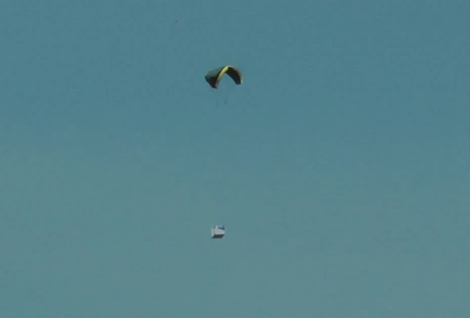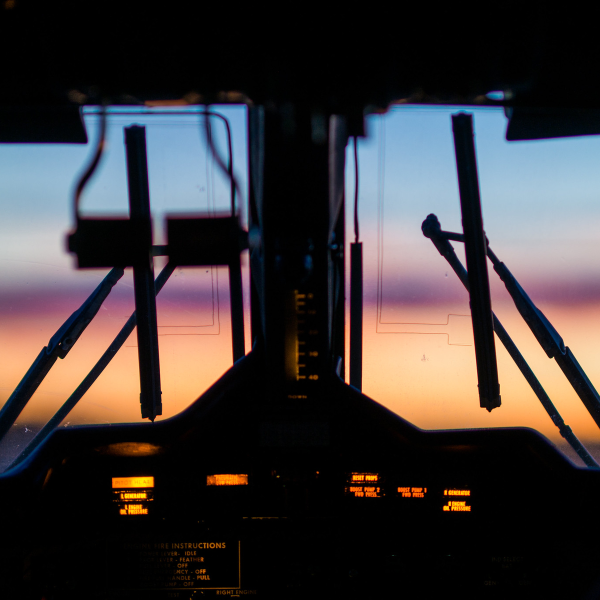
The biggest issue with sending expensive electronics into near space is trying to recover them. [Lhiggs] set out to solve this issue with his Senior project for a Mechanical Engineering degree. He figured that a payload dropped from 100,000 feet should be able to glide its way back to some predefined coordinates. Here you can see one of the tests, where the payload is guiding its descent using a parafoil.
Directional control is possible with a parafoil simply by shifting weight between the two supporting ropes. In this case [Lhiggs] designed the payload to hang from a pair of servo-motor-actuated arms. Since the payload already carries altitude and position hardware (such as a GPS, electronic compass, and altimeter) it’s just a matter of waiting for the target height before separating from the weather balloon, then using the servos to navigate to the landing zone.
Unfortunately the project was never fully completed. But you can see that he got pretty far. There is test footage embedded after the break showing the device being dropped from a plane.
[Thanks Dan]















There is a US Air Force System to drop and forget cargo on Parafoils: http://www.youtube.com/watch?v=yQlj5-aWdSk
That’s no cargo, that’s a… MOAB!!!
The parafoil was actually invented for the NASA gemini missions. They were originally designed to land on… land, I guess, and required a somewhat controlled descent.
Awesome to see this used for its intended purpose.
This is like model rocketry in reverse! :-D
There seems to be a very large chasm between the lofty goals of the project and the reality of the video posted above.
Yep. If you look at the AF video, you can see a trailing stabilizer. Now we know why! :)
What you are seeing is not a “trailing stabilizer”. It’s the pilot chute that inflates and pulls the main chute out of it’s container.
The parachute is unstable due to line twists, preventing the ability of the motors from steering the parafoil.
There are a couple ways this is caused and ways to resolve it:
The most obvious being the stability of the payload when it deploys. If it’s spinning, the parachute will be opening during that spin, but the chute won’t be spinning as much itself. Result: Lots of line twists.
Stabilizing wings [like an arrow] could be used to prevent spinning during freefall, thus allowing the parachute to open with a bit more stability.
Widening how far a part the parachute risers attach to the payload can also help. If they’re too close, it’s too easy for line twists to occur. If they’re a little more distant, then you can not only reduce line twists, but also ‘pull’ them out with the help of the motors in question.
Lastly, having the parachute deploy quicker by a pilot chute can also greatly improve stability. A small spring attachment could be used to deploy the pilot that pulls the main.
Looks like the lines on one end of the chute got twisted. Wasn’t any control of that drop happening.
Aero shape of the load and probable skew initially left it to spin all the way down. Skydiving may be the source of ideas to counter this. Stiff tails? The load and the sail must remain in the same plane of reference. If not big slew to limit….
Will be interesting to read what the community that make these balloon flights think of the concept. Before the advent of GPS telemetry the recovery teams has a decent recovery rate, that got even better when GPS was incorporated into a beacon transmitter that was already part of the package. No doubt many will experiment with this concept because that’s the reason for the flights in the first place. Bit will the decreased payload capacity be worth it?
Very similar to the High Altitude Glider Project. Seemed to be doing pretty well. Flight 4 seems to have gone the best.
http://web.archive.org/web/20110523214833/http://members.shaw.ca/sonde/
I hope this doesn’t mean they’re not bothering to recover the balloon.
Several years ago, somebody dropped a self-navigating model glider from a weather balloon. It made a couple successful flights before crashing in some mountains somewhere.
Most projects don’t recover the balloon – they are made of Latex and usually just burst into lots of little shreds. Latex is biodegradable and decomposes fairly quickly.
And if the balloon lands in a pasture, the cows will eat it DAMHIKT (Don’t Ask Me How I Know That)!
The autonomous glider project was featured on HD back in ’05… one of the first posts I read, and involved a significant engineering effort. Nowadays, there’s enough off the shelf hard/software out there I think we’re down to a careful integration effort to replicate the capability.
The parafoil class project obviously required a custom approach, and I love it. I wonder if it would still be considered a UAV, or not?
I know of one balloon that was recovered, but that was unplanned. A launch was attempted at the KS ARRL State convention at Wichita some years back off the top of a parking garage. As they where filling it the balloon took off. Later I learned. Later I learned it was a surplus balloon that turned out to be deteriorated it simply tore off the fill nipple.
Well, with expensive payloads such as ones with onboard radiation counters this could be handy.
Also for where you want to gather upper atmosphere samples.
Deploying the parachute after the balloon bursts is easy. Just hang your payload on the parafoil, tie the balloon to the middle of the parafoil. The balloon will mostly disable the parafoil on the way up, and it will be deployed the moment the balloon bursts.
The balloons get BIG in the upper atmosphere before it finally bursts though; might cause some issues with the parachute lines if the balloon is positioned under it.
I think it would’ve worked if they had static line deployed the pilot chute straight out of the plane, let it drop for a bit to stabilize and then pull the main out. Also, they need much much shorter lines, with them this long it’s asking for them to twist up.
Looks like the lines were twisted asymmetrically up as the parafoil deployed, causing the spin.
Seems a bit like the GPSBoomerang, except the it’s a glider that flies telemetry equipment back home using GPS.
All these projects use modified parachute. It would be more interesting to use modern paragliders. You can reach glide ratios of 1:10 with them. This means, with height loss of 1km vertically you can fly 10km horizontally. Parafoil max reach 1:3. Also paragliders stearing qualities are much better. Though they’re more problematic in deploying but with additional breaking chutes you could slow down enough.
I took part in a similar project, except at a smaller scale (and budget). I used only parts I had at hand, so the only sensor is GPS, and no compass. It is supposed to fly on an amateur rocket, about 800-1000m altitude. The parachute is about 1.2m wide. I should really finish the report on that…
If you can get 1:10 glide ratio, with 20 km of altitude you can get 200 km distance. Perfect for some nefarious purposes :) I suspect that we will see a lot of baloons on US south border soon :) And maybe in the Middle East.
DIY MegaFly